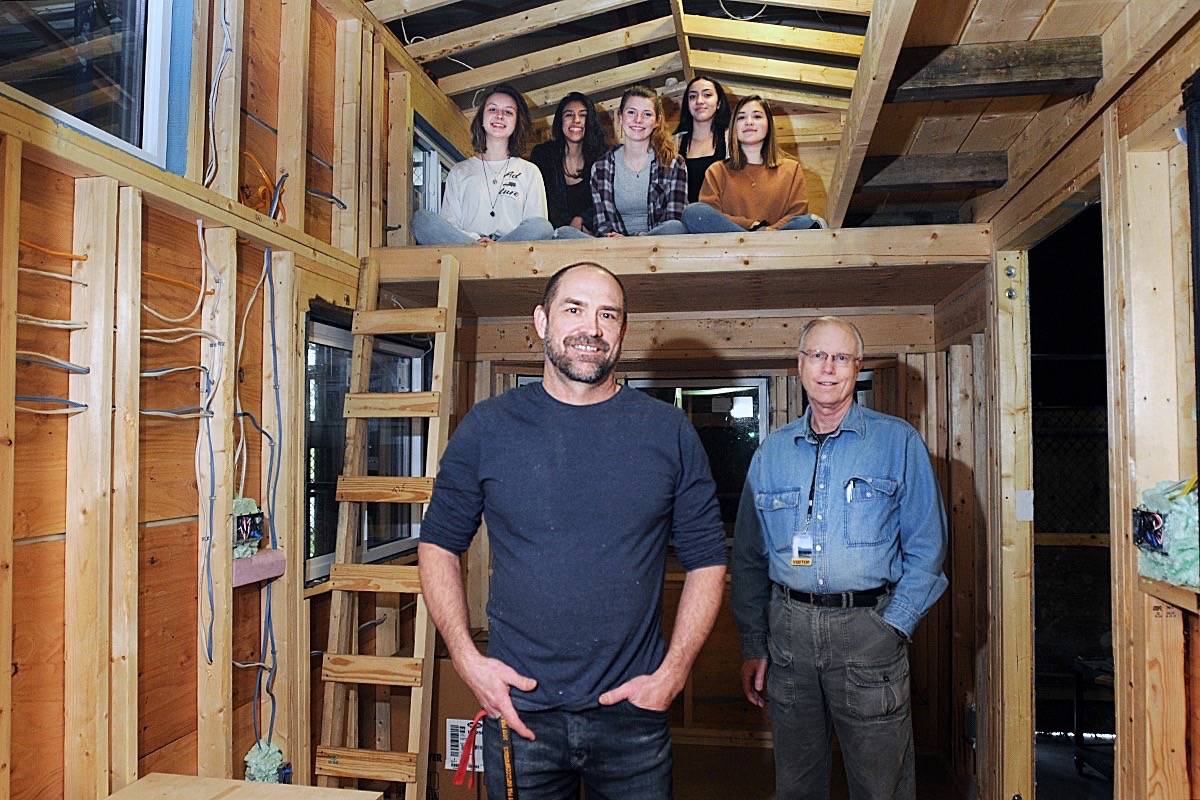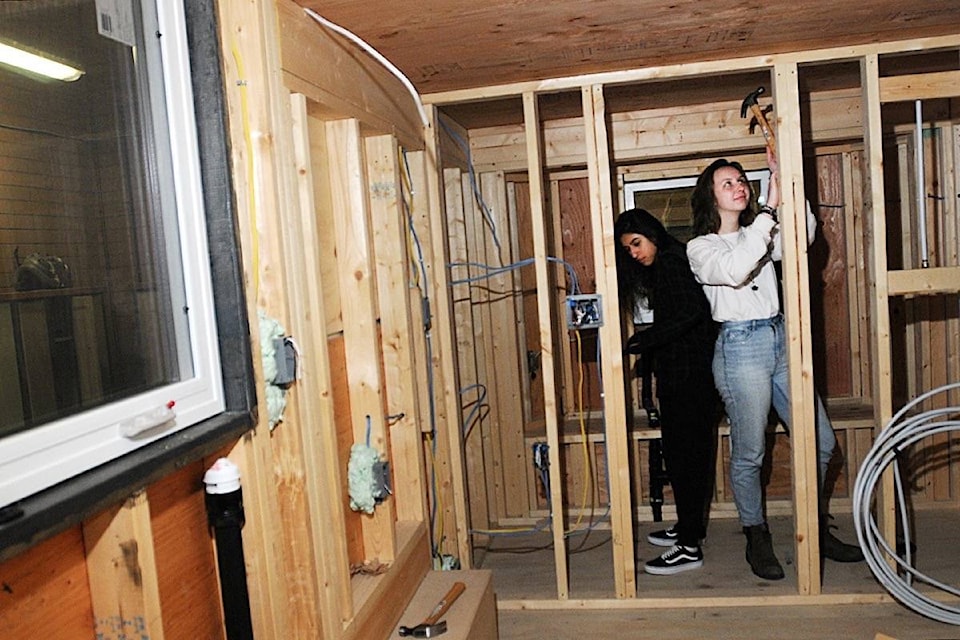The blue wooden structure sits atop a trailer in the workshop at Thomas Haney secondary.
It was affectionately named ‘Rhonda’ by the six students who designed and built the tiny house. They have been working on it for the past year and a half.
When you walk through the front entrance – the doors yet to be installed – you are stepping right into the living room. To the left of the basic wooden structure is the kitchen and bathroom, which will eventually include a stand-up shower, toilet and sink.
All the plumbing and electrical have been roughed in. Above are two lofts. On one side, the loft can fit a king-sized bed, and the other, a bit smaller, can be used as another sleeping area or for storage.
In all, the tiny house is 270 square feet.
Philip Brekkaas, shop teacher at Thomas Haney, started the project in September 2017. He got to know his tiny house team, a group of girls he first had for rotation in Grade 8, who came back for junior woodwork in Grade 9 and 10.
“They were really good about finishing projects, they were always on time, and they were really good on the tools,” he said.
The group talked about how great it would be to build a tiny home.
Brekkaas, who was a builder for 20 years before becoming a teacher, has been following tiny home builds since 2008, when the economy crashed and they became a trend in the United States.
Brekkaas, along with his wife, went to a meet-up group on the topic in Vancouver in 2012. At that time, there were only four people in the group. Now there are more than 500.
“More and more people were looking for ways to live and that’s what started my interest,” he said.
So Brekkaas received $10,000 in funding from the Industry Training Association to put towards a trailer that’s specifically engineered to support a tiny home.
Then the group started the project.
“I did a ton of research on layouts, so I did all my own plans and all my own drawings,” said Brekkaas.
“I got the girls involved in that process and then straight into framing and building.”
The process was slow because of the limited time the team had to work on the project. The first year, they only had one hour a week to spend on it together. This final year, half of them worked on it one hour every Monday morning and the other half an hour on Friday.
The rest of the work got done on their own time, in groups of twos or threes, coming in on the weekends to work on it.
The students learned how to use every tool in the shop.
“We learned to use the chop saw because we had to cut all our 2x4s to certain lengths. We used all the screws. For the first time, these tools are being used. They used all the cordless drills. Table saw. Basically, every tool I have in the shop has been used to build that,” Brekkaas said.
“There’s a sense of emergency when they are learning to use it because they have to know how to do it in order to build the next part.”
The most difficult part of the project for the students, now in Grade 11, was building the floor.
“Because it was cold at the time and also having to drill into the metal through the wood and then glue it down and they were all heavy planks of wood,” explained Daniella Pazos, one of the students.
“And this was the first task of [building] the house,” added another, Abby Buonafede.
Madi Seneviratne enjoyed being able to use all the tools the school shop had to offer, including the drills and nail gun.
The goal of the project is to get the house to the lock-up stage by the end of this school year in June. That means all the windows and doors have to be installed and the roof is on and the front door can be locked.
Somebody has already purchased the house, when the group was only two months into the project.
There were no labour costs involved. The new owner was charged $12,500 for materials used and an additional $6,000 in shop costs. The new owner also put in another $12,000 for materials to get the house to lock-up, including professionals who will come in to do the roofing, plumbing and electrical work.
“If you get to lock-up at $30,000, you’ve done really well,” said Brekkaas.
“It could be another $30,000 for finishing, depending on your choices,” he said, adding that that is where expenses can add up.
But, he added, that is the idea behind tiny homes. High-quality living, but live small. To reduce your cost of living, increase the time you have available in your life and invest in high quality furnishings.
Brekkaas sees tiny homes as a solution to the problem of helping people get into the housing market.
“People can start with an asset that’s on wheels that they can sell,” he said.
They can eventually pay it off over four or five years and use as a down payment towards the next step up, whether that be a condo or a townhouse.
“So laddering your way into the market rather than trying to save the big down payment,” he noted.
Gerry Pinel, with the Golden Ears Transition Initiative and also the Affordable Community Environment Society, became involved with the project just after it started.
His vision is to eventually build a tiny home community in Maple Ridge.
Every Monday, he drops by the school and helps the team with their project.
“There’s a movement out there for people not to just downsize but to consume less,” said Pinel, whose sister lives in a tiny house on Vancouver Island.
He wants to see tiny homes come “out of the bush and into the mainstream society.”
“It answers a whole bunch of questions of issues people are dealing with,” said Pinel.
“Affordability and being married to your mortgage and having a house to put all the stuff in that you consume,” he continued.
Pinel has been working with an organization out of Vancouver called Tiny House Festival Foundation who have been traveling all across Canada, talking to different communities and looking at zoning and bylaw restrictions to find ways to incorporate tiny homes into the main stream.
He said what they discovered is the most logical way of doing it is to create a community that incorporates small homes on small lots and then have a component of that community be around tiny homes.
Pinel and ACES have been in some discussions with the City of Maple Ridge about creating what they have called the Shire concept, creating a complete, self-sufficient community that has residential, commercial and agricultural components, based on co-housing principals.
He said about 10 acres are needed. He is looking at a time frame of five years to have a tiny home community built here.
Brekkaas is looking for a new team for another two-year tiny home project and is hoping graduating teams will come back to train new participants.
Every member of the team said they would consider living in a tiny house.
“I would live in a tiny house, 100 per cent,” said Gabby Dujmovic.
“I just think it’s like really cool how you can move around and if it’s just you and one other person, it’s, like, really cool because you can live small and it’s better for the environment.”
And now the girls have the skills, and experience, to build their own homes.

